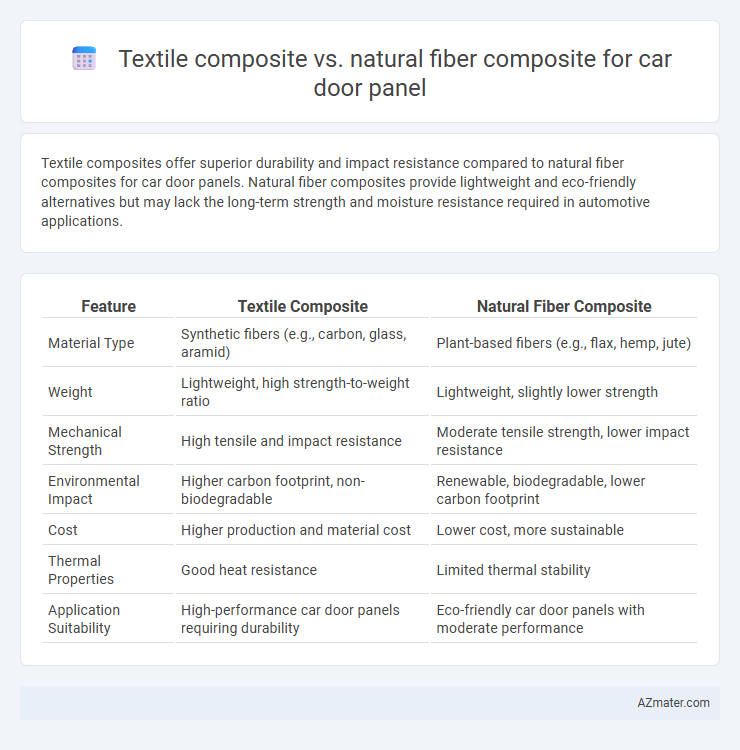Textile composites offer superior durability and impact resistance compared to natural fiber composites for car door panels. Natural fiber composites provide lightweight and eco-friendly alternatives but may lack the long-term strength and moisture resistance required in automotive applications.
Table of Comparison
| Feature | Textile Composite | Natural Fiber Composite |
|---|---|---|
| Material Type | Synthetic fibers (e.g., carbon, glass, aramid) | Plant-based fibers (e.g., flax, hemp, jute) |
| Weight | Lightweight, high strength-to-weight ratio | Lightweight, slightly lower strength |
| Mechanical Strength | High tensile and impact resistance | Moderate tensile strength, lower impact resistance |
| Environmental Impact | Higher carbon footprint, non-biodegradable | Renewable, biodegradable, lower carbon footprint |
| Cost | Higher production and material cost | Lower cost, more sustainable |
| Thermal Properties | Good heat resistance | Limited thermal stability |
| Application Suitability | High-performance car door panels requiring durability | Eco-friendly car door panels with moderate performance |
Introduction to Automotive Composite Materials
Textile composites and natural fiber composites are key materials in automotive door panel manufacturing, offering distinct advantages in weight reduction and sustainability. Textile composites leverage synthetic fibers such as carbon or glass, providing superior strength and impact resistance essential for safety and durability standards. Natural fiber composites utilize renewable fibers like flax or hemp, enhancing environmental benefits and reducing vehicle carbon footprint while maintaining adequate mechanical performance.
Overview of Textile Composites
Textile composites for car door panels leverage woven or non-woven reinforcement fibers combined with polymer matrices, offering high strength-to-weight ratios and enhanced impact resistance. These composites enable superior design flexibility, improved surface finish, and better durability compared to natural fiber composites, which often suffer from moisture absorption and lower mechanical performance. Advanced textile composites utilize materials such as carbon fiber, glass fiber, and aramid fiber, optimizing structural integrity and weight reduction in automotive applications.
Natural Fiber Composites Explained
Natural fiber composites for car door panels utilize renewable fibers such as flax, jute, or hemp combined with polymer matrices, offering advantages in weight reduction, cost efficiency, and environmental sustainability over traditional textile composites. These composites provide enhanced biodegradability and lower carbon footprints while maintaining adequate mechanical properties for automotive applications. Innovations in natural fiber treatments and hybridization with synthetic fibers further improve durability and moisture resistance, making them a viable alternative for eco-friendly vehicle manufacturing.
Mechanical Properties: Textile vs Natural Fiber
Textile composites exhibit superior tensile strength and impact resistance compared to natural fiber composites, making them ideal for car door panel applications requiring durability and safety. Natural fiber composites offer better vibration damping and lower density, contributing to enhanced cabin comfort and weight reduction in automotive design. The mechanical performance balance between synthetic textiles and natural fibers depends on the specific fiber treatment, composite matrix, and manufacturing process employed.
Weight and Density Comparisons
Textile composites used in car door panels typically exhibit higher density values, ranging from 1.2 to 1.8 g/cm3, compared to natural fiber composites, which usually have densities between 0.9 and 1.3 g/cm3. The lower density of natural fiber composites contributes to a significant weight reduction, enhancing vehicle fuel efficiency and overall performance. Weight savings of up to 20-30% are achievable with natural fiber composites without compromising structural integrity, making them an attractive alternative for lightweight automotive applications.
Sustainability and Environmental Impact
Textile composites made from synthetic fibers often rely on petrochemical-based materials, leading to higher carbon emissions and challenges in biodegradability compared to natural fiber composites derived from flax, hemp, or jute, which offer renewable and biodegradable properties. Natural fiber composites demonstrate lower energy consumption during production and contribute to reduced vehicle weight, enhancing fuel efficiency and lowering overall environmental impact. The disposal and recyclability of natural fiber composites further advance sustainability by minimizing landfill waste and promoting circular economy principles in automotive manufacturing.
Cost Analysis and Economic Feasibility
Textile composites offer higher initial material and processing costs due to advanced fiber architectures and resin systems, whereas natural fiber composites provide cost advantages through abundant raw materials and lower energy requirements. The economic feasibility of natural fiber composites improves with reduced environmental impact and lighter weight, translating into potential fuel savings and tax incentives in automotive manufacturing. However, textile composites deliver superior durability and performance, potentially lowering long-term maintenance expenses despite higher upfront investments.
Manufacturing Processes and Scalability
Textile composites for car door panels often utilize advanced manufacturing processes such as resin transfer molding (RTM) and compression molding, enabling high precision and repeatability, which supports large-scale production. Natural fiber composites, typically processed through techniques like injection molding with short fibers or hand lay-up methods, offer cost-effective scalability but face challenges in consistent quality and moisture sensitivity. The scalability of textile composites benefits from automated processes and controlled curing cycles, whereas natural fiber composites require optimization in fiber treatment and matrix compatibility to enhance manufacturing efficiency and product uniformity.
Performance in Automotive Applications
Textile composites in car door panels offer superior mechanical strength, durability, and high impact resistance, making them ideal for safety-critical automotive applications. Natural fiber composites provide lightweight and eco-friendly alternatives with good vibration damping and moderate strength but generally fall short in long-term durability and moisture resistance compared to textile composites. Performance optimization in automotive door panels often involves balancing weight reduction, structural integrity, and environmental sustainability, where textile composites currently lead in high-performance requirements.
Future Trends in Car Door Panel Materials
Future trends in car door panel materials emphasize the growing adoption of natural fiber composites due to their sustainability, lightweight properties, and reduced environmental impact compared to traditional textile composites. Advances in bio-based resin systems and enhanced fiber treatments are improving the mechanical performance and durability of natural fiber composites, making them increasingly viable for automotive applications. Integration of smart technologies and recyclability features in these composites aligns with automotive industry goals for eco-friendly, high-performance car door panels.

Infographic: Textile composite vs Natural fiber composite for Car door panel
 azmater.com
azmater.com